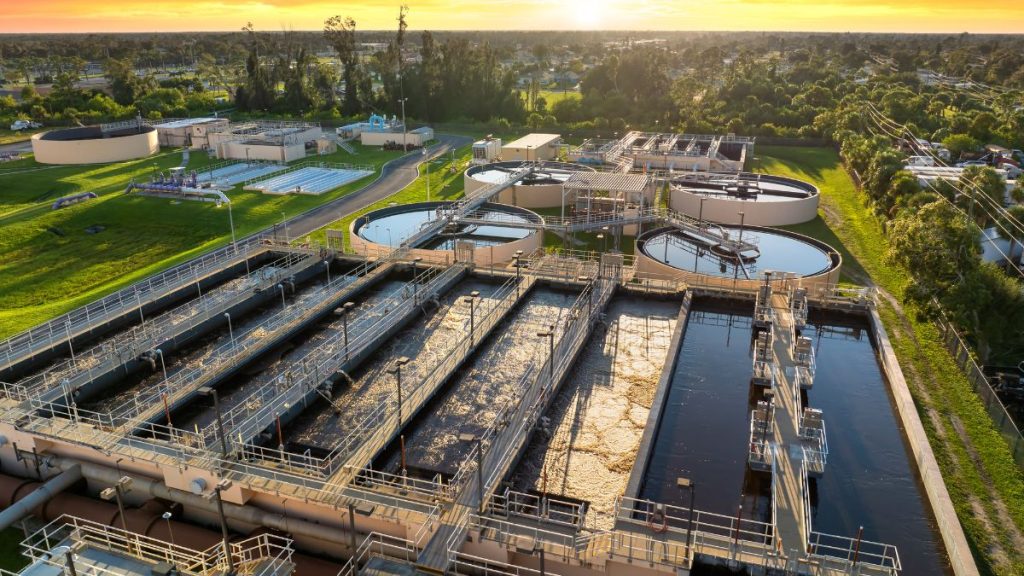In wastewater treatment plants, sludge dewatering plays a crucial role in reducing the volume of sludge generated from various treatment processes. This step not only lowers disposal costs but also minimizes environmental impact and enhances overall plant efficiency.
As industries face increasing demands for sustainable operations and regulatory compliance, optimizing sludge dewatering has become a priority for achieving cost-effective and eco-friendly wastewater management.
What Is Sludge Dewatering?
Sludge dewatering is a mechanical process used to remove as much water as possible from sludge, the semi-solid byproduct produced during wastewater treatment. The goal is to reduce sludge volume, making it easier and cheaper to handle, transport, and dispose of. Unlike thickening, which focuses on concentrating solids, dewatering transforms sludge into a solid or cake-like form with significantly lower water content.
This process typically follows biological or chemical treatment stages and can be applied to both municipal and industrial wastewater systems. Common methods of sludge dewatering include:
- Centrifugation: Uses centrifugal force to separate water from solid particles efficiently.
- Belt Filter Press: A continuous process where sludge passes between filter belts under pressure to extract water.
- Plate and Frame Filter Press: Involves a batch process that applies high pressure to produce dry sludge cakes.
- Screw Press: Operates at low speed with minimal energy consumption, suitable for various sludge types.
Each method has specific advantages depending on sludge characteristics, plant size, and disposal requirements.
Read Also: Getting to Know the Dewatering Process and the Best Methods for Water Treatment
Strategies for Optimizing Sludge Dewatering
To maximize the efficiency of sludge dewatering, several strategies can be implemented, combining both mechanical improvements and chemical conditioning approaches. Below are key strategies to achieve better performance and reduced operational costs.
1. Proper Sludge Conditioning
Effective conditioning is essential to enhance dewatering performance. This involves adding chemical agents, such as coagulants and flocculants, to improve the aggregation of fine particles, forming larger flocs that release water more easily during dewatering.
- Coagulants: Chemicals like Poly-Aluminium Chloride (PAC) or Aluminium Sulfate neutralize the negative charges of sludge particles, allowing them to clump together.
- Flocculants: Anionic or cationic polymers further strengthen these flocs, improving water separation efficiency.
Selecting the right combination and dosage of conditioning agents can significantly increase dewatering rates and reduce the moisture content of the final sludge cake.
2. Optimizing Equipment Performance
Mechanical equipment performance directly affects dewatering results. Regular inspection, maintenance, and parameter adjustments, such as belt speed, feed rate, and pressure, are vital for maintaining high efficiency. For instance:
- Increasing the pressure in a filter press can improve cake dryness.
- Adjusting centrifuge speed helps achieve optimal separation without damaging sludge flocs.
- Cleaning filter media regularly prevents clogging and maintains consistent throughput.
Using advanced monitoring and control systems also helps operators track real-time performance, detect anomalies, and ensure consistent results.
Read Also: Understanding the Sludge Thickening Process: Optimizing Water Treatment Efficiency
3. Managing Sludge Feed Characteristics
The nature of the sludge (its origin, particle size distribution, and organic content) has a significant impact on dewatering efficiency. High organic content or colloidal materials make sludge more difficult to dewater. Implementing upstream process control to stabilize sludge properties can therefore improve downstream performance.
Key measures include:
- Controlling biological process conditions to produce stable sludge.
- Adjusting pH to enhance floc formation and water release.
- Minimizing oil, grease, or fibrous materials that interfere with mechanical separation.
4. Integrating Polymer Optimization Programs
Automated polymer feed systems and optimization programs can ensure precise dosing based on sludge variability. This prevents overuse of chemicals, reduces operational costs, and maintains stable dewatering performance. Conducting regular jar tests and performance audits helps determine the most effective polymer types and concentrations for specific sludge types.
5. Leveraging Process Automation and Data Monitoring
Modern sludge dewatering systems can be integrated with IoT-based monitoring and automated control systems. These technologies enable operators to monitor performance indicators—such as flow rate, torque, dryness, and chemical usage—in real time. The data collected supports predictive maintenance and continuous process improvement.
By combining automation with analytical tools, facilities can make data-driven decisions to optimize performance and minimize downtime.
6. Ensuring Proper Operation and Maintenance
Training operators on proper equipment handling and maintenance routines is critical. A well-maintained dewatering system not only enhances reliability but also prolongs equipment life. Maintenance should include:
- Regular inspection of bearings, belts, and filter fabrics.
- Lubrication schedules for moving parts.
- Calibration of sensors and flow meters to maintain accuracy.
A preventive maintenance program minimizes unexpected failures and ensures stable operation under varying sludge loads.
The Benefits of Efficient Sludge Dewatering
Optimizing sludge dewatering provides multiple operational, environmental, and economic benefits across industries. Below are the key advantages of an efficient dewatering process:
1. Reduced Sludge Volume and Disposal Costs
The most direct benefit of sludge dewatering is the significant reduction in sludge volume, often by 70% or more. With less water content, the weight and volume of sludge decrease dramatically, leading to lower transportation and disposal costs. This is particularly beneficial for facilities where disposal costs are based on tonnage or volume.
Read Also: How to Overcome High Sludge Volume Index (SVI) in Wastewater Treatment
2. Improved Handling and Storage
Dewatered sludge in cake form is easier to handle, store, and transport compared to liquid sludge. It minimizes the risk of spills, odors, and contamination during handling and allows for more efficient logistics management.
3. Enhanced Energy Recovery and Resource Utilization
Dewatered sludge can be repurposed for energy recovery through incineration or anaerobic digestion. With higher solid content, it provides a more efficient fuel source for waste-to-energy processes, contributing to sustainability and circular economy initiatives.
4. Lower Environmental Impact
Reducing water content in sludge lessens the risk of leachate formation during transportation and disposal, thus preventing groundwater contamination. Moreover, efficient dewatering minimizes the overall environmental footprint of wastewater treatment plants.
5. Compliance with Environmental Regulations
Stringent regulations often require industries to minimize the volume and moisture content of their waste before disposal. Properly managed dewatering processes ensure compliance with national and local standards, avoiding potential penalties or environmental liabilities.
6. Operational Efficiency and Cost Savings
An optimized dewatering system results in lower chemical consumption, reduced energy use, and fewer operational disruptions. Over time, this translates into measurable cost savings and improved return on investment for water treatment facilities.
Partnering with Lautan Air Indonesia for Sludge Dewatering Solutions
Achieving efficient and reliable sludge dewatering requires not only the right technology but also the expertise to tailor solutions based on specific plant conditions. Lautan Air Indonesia (LAI) brings over four decades of experience in providing comprehensive water and wastewater treatment solutions for various industries across Indonesia.
Our services and solutions for sludge dewatering include:
- Customized Chemical Programs: Selection and supply of high-quality coagulants, flocculants, and polymers tailored to your sludge characteristics.
- System Optimization and O&M Services: Operation and maintenance support to ensure consistent equipment performance and reduced downtime.
- Automation and Monitoring Systems: Integration of smart control and IoT-based monitoring systems for real-time process optimization.
- Technical Support and Training: On-site technical assistance and operator training to maintain long-term system reliability and efficiency.
Whether your goal is to reduce disposal costs, improve sludge dryness, or enhance environmental compliance, Lautan Air Indonesia delivers end-to-end solutions—from chemical supply and system design to operation and maintenance services.
Contact Lautan Air Indonesia today to discover how our advanced sludge dewatering solutions can help optimize your operations, reduce costs, and protect the environment.



